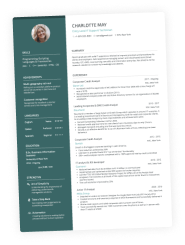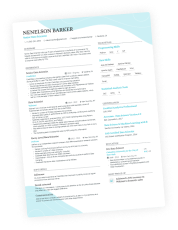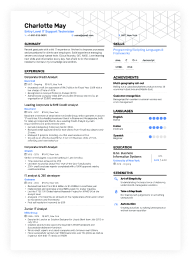Your name is the first thing a recruiter sees. But what if your legal name isn’t the one you use every day? Whether you go by a shortened, chosen, or one that better reflects your identity, your preferred name deserves space on your resume.
According to a 2023 CNBC report, nearly 20% of job seekers have changed their names on resumes to avoid discrimination, reflecting how personal and professional identity often intersect in hiring.
This guide explains when to use your preferred name, what to expect from employers, and how to keep your resume consistent across every detail.
Key takeaways
- It’s acceptable to use your preferred name on your resume.
- Your legal name is only required later for HR or background checks.
- Use the same name across your resume, cover letter, and online profiles.
- If your legal name appears on credentials, you can note it in your summary.
- Choose the version of your name that feels true to you and fits your professional image.
Show your true colors. Use this template to create a resume that represents you—professionally, confidently, and authentically.
Can you put a preferred name on your resume?
Yes—and it’s completely professional to do so. Your resume represents the professional identity you use every day, not just what’s printed on your legal documents. If your preferred name is the one you use in daily communication or online, it belongs on your resume.
Employers will only need your legal name later in the hiring process for HR or verification purposes. Until then, what matters most is clarity and consistency.
If you’d introduce yourself by that name in an interview, you can confidently use it on your resume.
Now, let’s see in what situations it makes sense to use your preferred name.
When and why to use your preferred name on a resume
There are several valid reasons to use a preferred name on your resume:
- Shortened versions: You go by Sam instead of Samantha.
- Cultural clarity: You use an anglicized name, like Wei (William) Zhang.
- Gender affirmation: You use a name that aligns with your identity.
- Personal or marital changes: You’ve recently changed your name.
- Confidence and comfort: You prefer to be addressed that way at work.
Your preferred name shows who you are today—not just what appears on legal records. Here’s how to use it effectively.
How to put your preferred name on a resume
Once you’ve decided to use your preferred name, present it clearly and professionally.
Your resume should reflect how you want to be addressed while keeping your legal name available for any later verification or paperwork.
PRO TIP
In countries like the U.S., UK, Canada, Australia, and New Zealand, resumes aren’t legal documents, so you can safely use your preferred name.
However, some roles require formal identification, visa processing, or credential checks. In fields like government, healthcare, or academia, or when relocating internationally—it’s best to use your legal name or list both for clarity.
Best for: Private-sector jobs and international applications where resumes aren’t tied to formal ID checks.
If your credentials or past records use a different name, consider listing both your legal and preferred names instead.
2. Legal + preferred name
If your legal name appears on degrees, certifications, or previous employment records, it’s smart to show both. This approach prevents confusion and helps hiring teams match your credentials easily.
You can format your name using quotation marks or parentheses, whichever looks cleaner with your layout.
Using quotation marks:
Using parentheses:
If you prefer a simpler header but still want to clarify both names, mention your legal name in your summary instead. This keeps your preferred name visually primary while staying transparent.
Alternative layout (simpler header, legal name in summary):
Summary example:
Best for: International roles, education, or government settings where HR will later verify credentials.
If you work internationally or want to express your authentic identity, the next format might suit you better.
3. International or gender-affirming name
Some candidates adapt their names to improve communication or to align with theiridentity. This format helps with pronunciation, inclusivity, and authenticity while keeping a professional tone.
If you have an international background, using an anglicized or alternate first name can make introductions easier without losing your cultural connection.
For chosen or gender-affirming names, this layout allows you to present yourself authentically.
You may also include your pronouns next to your name if you’re comfortable doing so—it promotes clarity and inclusivity in global workplaces.
Best for: Global companies, inclusive workplaces, or applicants using a chosen or anglicized name professionally.
Once you’ve chosen the layout that fits your situation, the next step is reviewing your resume for consistency.
Here’s a quick overview of how each header format works best:
Resume name format comparison
| Header format | Best for | Notes |
|---|---|---|
| SAM LEE | Private-sector roles | Use if your preferred name is already consistent across platforms. |
| SAMANTHA “SAM” LEE / SAMANTHA (SAM) LEE | Government, education, or credential verification | Combine legal and preferred names for clarity. |
| WEI (WILLIAM) ZHANG / ALEX TAYLOR (they/them) | International or inclusive workplaces | Ideal for global or gender-affirming name use. |
Once your resume layout feels right, take a moment to review the final details below.
Before submitting your application
If you use a preferred name, double-check that it’s consistent across your professional materials. A few quick checks can prevent confusion during hiring.
Final review before sending your resume
- Confirm it matches your LinkedIn and email address.
- If your legal name appears on credentials, note it in your summary.
- Check the consistency of your file name and resume header.
- Use the same version across all communication channels.
- Save a version with your legal name for formal paperwork.
Run your resume through Enhancv’s Resume Checker to ensure your layout, sections, and personal details look polished and consistent.
Most common questions
Here are a few common questions job seekers have about using preferred names.
Do I have to use my legal name on job applications?
Only if the form specifically asks for it. Most employers only need your legal name later, during background checks.
Can I use my preferred name on LinkedIn and my legal name on my resume?
It’s best to stay consistent; using the same name across platforms avoids confusion.
Should I mention my preferred name in my cover letter?
Only if your legal name is also present on your resume or certificates.
Conclusion
Using your preferred name on a resume is a simple but powerful way to take ownership of your professional identity. It tells employers, “This is who I am—and this is how I want to be addressed.”
Whether you’re using a shortened version, an anglicized name, or a chosen one, keep it consistent, clear, and genuine.
Your resume should reflect not just your experience but also how you want to be recognized in your career—with confidence and consistency.
Make one that's truly you.




